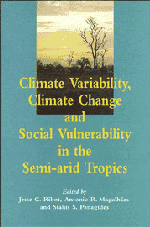Book contents
- Frontmatter
- Contents
- List of contributors
- Foreword by Tom Downing
- Preface
- List of abbreviations
- Introduction. Climate Variability, Climate Change and Vulnerability: Moving Forward by Looking Back
- PART I OVERVIEW
- PART II CLIMATE VARIATION, CLIMATE CHANGE AND SOCIETY
- 2 Climate Change and Variability in Mexico
- 3 The Impact of Climate Variation and Sustainable Development in the Sudano-Sahelian Region
- 4 Climate Change and Sustainable Development in China's Semi-arid Regions
- 5 Settlement Advance and Retreat: A Century of Experience on the Eyre Peninsula of South Australia
- PART III CLIMATE VARIABILITY AND VULNERABILITY: CAUSALITY AND RESPONSE
- PART IV THE INTERNATIONAL CONFERENCE ON THE IMPACTS OF CLIMATIC VARIATIONS AND SUSTAINABLE DEVELOPMENT IN SEMI-ARID REGIONS (ICID)
3 - The Impact of Climate Variation and Sustainable Development in the Sudano-Sahelian Region
Published online by Cambridge University Press: 02 December 2009
- Frontmatter
- Contents
- List of contributors
- Foreword by Tom Downing
- Preface
- List of abbreviations
- Introduction. Climate Variability, Climate Change and Vulnerability: Moving Forward by Looking Back
- PART I OVERVIEW
- PART II CLIMATE VARIATION, CLIMATE CHANGE AND SOCIETY
- 2 Climate Change and Variability in Mexico
- 3 The Impact of Climate Variation and Sustainable Development in the Sudano-Sahelian Region
- 4 Climate Change and Sustainable Development in China's Semi-arid Regions
- 5 Settlement Advance and Retreat: A Century of Experience on the Eyre Peninsula of South Australia
- PART III CLIMATE VARIABILITY AND VULNERABILITY: CAUSALITY AND RESPONSE
- PART IV THE INTERNATIONAL CONFERENCE ON THE IMPACTS OF CLIMATIC VARIATIONS AND SUSTAINABLE DEVELOPMENT IN SEMI-ARID REGIONS (ICID)
Summary
INTRODUCTION
The Sudano-Sahelian region is the strip of land south of the Sahara Desert extending across Africa from the Atlantic coast on the west to the Red Sea and the Indian Ocean to the east. The region becomes broader in the east to include the drier parts of Ethiopia, northern Uganda, Kenya and Tanzania (Fig. 1). The region embraces three ecological zones: the Saharo-Sahelian transition (arid), the Sahel (semi-arid) and the Sahelo-Sudanian (sub-humid).
The Saharo-Sahelian transition (arid) zone is characterized by low annual rainfall of 100–200 millimeters (mm) which also shows high inter-annual variability (50–100%). Climatologically, the humidity index, which is defined as the ratio of annual precipitation to potential evapotranspiration (P/ETP), is in the range 0.03–0.2. The vegetation is sparse and includes bushes and small woody, thorny or leafless scrub. In this zone, rainfed agriculture is not viable except in a few isolated flood-plain microenvironments. The main production enterprise is pastoralism.
The Sahel (semi-arid) and Sahelo-Sudanian (sub-humid) zones have better but still highly variable rainfall regimes (Fig. 2). The mean annual rainfall is in the range of 200–400 mm and 400–800 mm, respectively, with 25–50% interannual variability. The humidity index is in the range 0.2–0.5.
Rainfall distribution over most of the region is monomodal, occurring during the months of June, July and August, but the arid and semi-arid areas of Eastern Africa have two rainfall peaks, one in March and the other in May. It is this concentration of rainfall which supports crop production in spite of the high evaporation rates.
- Type
- Chapter
- Information
- Publisher: Cambridge University PressPrint publication year: 1996
- 5
- Cited by



